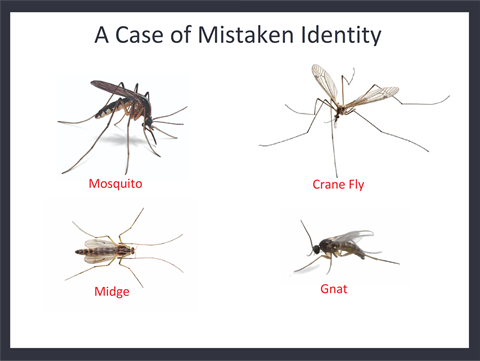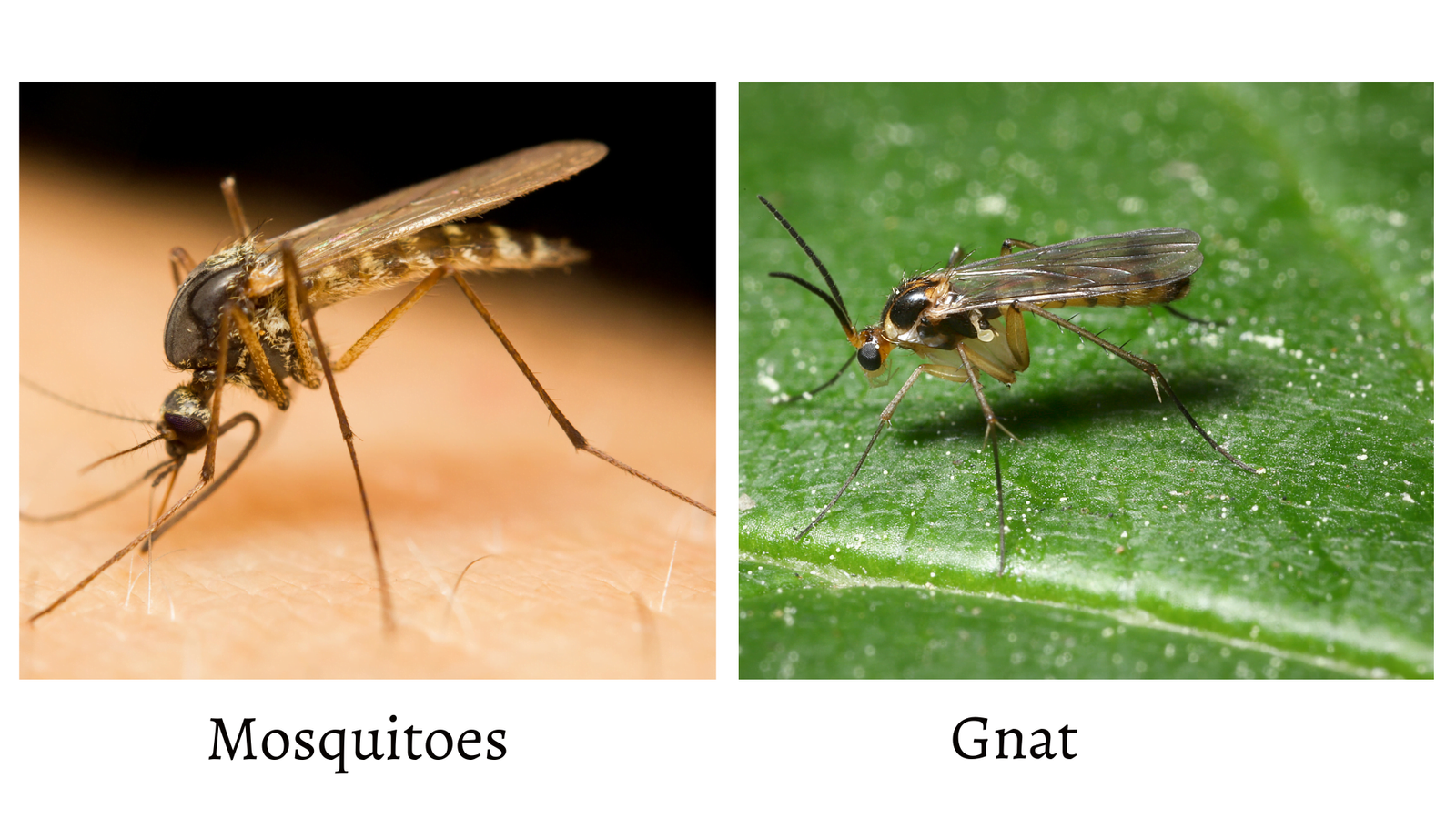Mosquitoes and gnats differ in size and behavior. Mosquitoes are larger and feed individually, while gnats are smaller and often swarm in groups.
Mosquito bites are larger and heal faster than gnat bites, which are smaller, darker, and take longer to heal. Knowing the difference can help in identifying and managing these pests effectively. Mosquitoes and gnats are common nuisances, and it’s essential to understand their distinctions.
Mosquitoes, characterized by their larger size and solitary feeding behavior, are often found outdoors, while gnats, smaller in size and known for swarming, can be found indoors and outdoors. Distinguishing between their bites, with mosquito bites being larger and healing faster, and gnat bites being smaller, darker, and slower to heal, is crucial for appropriate treatment. By recognizing these differences, individuals can better address and manage issues related to mosquitoes and gnats.
Introduction To Mosquitoes And Gnats
Welcome to our guide on the difference between mosquitoes and gnats. These tiny insects can be a nuisance, especially during the warmer months. In this post, we’ll explore the visual distinctions and habitat preferences of mosquitoes and gnats, helping you better understand these pesky creatures.
Visual Distinctions
When it comes to visual differences, mosquitoes are usually larger than gnats and have a long, needle-like proboscis used for feeding on blood. They are often darker in color and have a more noticeable elongated body. On the other hand, gnats are smaller in size and have delicate, slender bodies. Their appearance is often more fragile compared to mosquitoes.
Habitat Preferences
Mosquitoes are commonly found near areas of standing water, such as ponds, marshes, and stagnant pools. They are most active during dawn and dusk, and their breeding sites are typically associated with water sources. Gnats, on the other hand, prefer moist environments such as overwatered plants, decaying organic matter, and damp soil. They can also be found in and around homes, especially in areas with high humidity.
Physical Characteristics
Distinguishing between mosquitoes and gnats can be tricky. Mosquitoes are larger and bite individually, while gnats are smaller, darker, and often swarm in groups. Mosquito bites heal faster compared to gnats, which leave rougher, slower-healing marks.
Size Comparison
Gnats are smaller than mosquitoes, with slender bodies. Gnats are often found indoors or in large swarms outdoors, while mosquitoes fly individually. Both can transmit diseases.Wing Structure And Flight Patterns
Mosquitoes have distinct long, narrow wings for flight. Gnats also have delicate wings but are known to fly in erratic patterns compared to the more straightforward flight of mosquitoes.Behavioral Differences
Distinguishing between mosquitoes and gnats can be tricky. Mosquito bites are larger, while gnat bites are smaller and darker, taking longer to heal. Mosquitoes often travel alone, while gnats are commonly found in swarms. Both can transmit diseases and are bothersome pests.
Feeding Habits
Mosquitoes and gnats have different feeding habits. Mosquitoes feed on blood, which is necessary for their reproduction. Only female mosquitoes feed on blood, while males prefer nectar. Gnats, on the other hand, are mostly herbivores and feed on plant sap and decaying organic matter. Some species of gnats are also predatory and feed on other insects.Swarming Tendencies
Gnats are known for their swarming tendencies and can often be seen in large numbers in the air. They may form swarms to mate or to feed on plant sap. Mosquitoes, on the other hand, do not swarm in the same way as gnats. They tend to fly solo and search for their food source individually.Overall, while mosquitoes and gnats may share some similarities, such as their small size and ability to be a nuisance, their behavioral differences set them apart. Knowing these differences can help with identifying and effectively controlling these pests.
Credit: www.morriscountynj.gov
Life Cycle And Reproduction
Egg-laying Environments
Mosquitoes typically lay their eggs in stagnant water, such as ponds, marshes, or even in containers with standing water. On the other hand, gnats prefer to lay their eggs in decaying organic matter, damp soil, or in areas with fungal growth, such as over-watered houseplants or in moist outdoor environments.
Development Stages
The life cycle of a mosquito consists of four stages: egg, larva, pupa, and adult. The eggs hatch into larvae, which then develop into pupae before emerging as adult mosquitoes. In contrast, gnats go through a similar life cycle, with eggs hatching into larvae, then pupating before maturing into adult gnats.
Bite Identification
Gnats and mosquitoes differ in several ways, including their size, appearance, and bite. Gnat bites are smaller, darker, and take longer to heal compared to mosquito bites. Gnats are often found in homes or swarming in the air, while mosquitoes travel individually and can carry diseases.
Mosquito Bite Traits
Mosquito bites are identified by their raised, itchy, and reddish bumps. These bites are usually larger than gnat bites and can be accompanied by a clear central area. Mosquito bites tend to heal faster than gnat bites.
Gnat Bite Attributes
Gnat bites appear as small, darker, and rough-looking bumps. They take longer to heal compared to mosquito bites. Gnat bites are often accompanied by itchiness and irritation.

Credit: www.morriscountynj.gov
Health Implications
Mosquitoes and gnats differ in size and behavior. Gnats are smaller and often found in homes or swarming in the open air, while mosquitoes travel individually in search of food. Both can carry diseases and are a nuisance, with gnat bites causing tiny, itchy red bumps.
Disease Transmission
Mosquitoes are known to transmit diseases such as malaria and Zika virus through their bites. They can also spread West Nile virus and dengue fever.
Gnats, on the other hand, are not known to transmit diseases to humans. Their bites are more of a nuisance than a health risk.
Allergic Reactions
Some individuals may experience allergic reactions to mosquito bites, resulting in itching, swelling, and redness at the bite site. Severe allergic reactions can occur in rare cases.
Gnat bites, although less common, can also cause itching and irritation. In some instances, gnat bites may lead to allergic reactions, manifesting as red bumps and discomfort.
Preventative Measures
Distinguishing between mosquitoes and gnats can be tricky. Mosquitoes are larger and known for their itchy bites, while gnats are smaller and tend to swarm in groups. Mosquito bites are usually larger and more irritating than gnat bites.
Avoidance Strategies
The best way to prevent mosquito and gnat bites is to avoid being around them altogether. Mosquitoes are more active during dawn and dusk, so it’s best to avoid outdoor activities during those times. Gnats, on the other hand, are more active during the day and can be found in damp environments. It’s important to keep your home and surroundings clean and dry to prevent gnats from breeding.Home And Garden Treatments
There are many home and garden treatments that can help prevent mosquitoes and gnats from infesting your home. Mosquitoes breed in standing water, so make sure to eliminate any standing water sources around your home. You can also use mosquito repellents and bug zappers to keep them at bay. To prevent gnats, make sure to seal any cracks or openings in your home, and use a dehumidifier to reduce moisture in the air.Preventing mosquito and gnat bites can be a challenge, but it’s not impossible. By following these simple avoidance strategies and using effective home and garden treatments, you can keep these pesky bugs at bay. Remember to always protect yourself and your family by wearing protective clothing and using bug repellents when outdoors.
Credit: thepestrangers.com
Control And Eradication
Mosquitoes and gnats are both pesky insects that can disrupt outdoor activities and pose health risks. Controlling and eradicating these pests is essential to create a comfortable and safe environment. There are various methods for managing mosquito and gnat populations, ranging from natural remedies to chemical solutions.
Natural Remedies
- Essential oils: Certain essential oils such as citronella, lavender, and eucalyptus are known to repel mosquitoes and gnats.
- Plants: Growing plants like marigolds, basil, and mint can help deter these insects from your outdoor spaces.
- Remove standing water: Eliminating stagnant water sources where mosquitoes breed can significantly reduce their population.
- Use mosquito dunks: These contain a natural bacteria that kills mosquito larvae in standing water, preventing them from maturing into biting adults.
Chemical Solutions
- Insect repellents: Applying repellents containing DEET or picaridin can effectively ward off mosquitoes and gnats.
- Insecticides: Using approved insecticides in outdoor areas can help control mosquito and gnat populations.
- Larvicides: Applying larvicides to water sources can target mosquito larvae and prevent them from developing into flying insects.
- Fogging: This method involves dispersing insecticide aerosols to eliminate adult mosquitoes and gnats in outdoor spaces.
Frequently Asked Questions
How To Tell The Difference Between A Mosquito Bite And A Gnat Bite?
Gnat bites are darker, smaller, and rougher than mosquito bites. They take longer to heal.
Are Gnats And Mosquitoes The Same?
Gnats and mosquitoes are not the same. Gnats are smaller and often found indoors, while mosquitoes are larger and bite people.
Do Gnats Bite Humans?
Yes, some species of gnats bite humans, causing tiny, itchy red bumps. Gnat bites are distinguishable by their darker, rough appearance and slower healing time compared to mosquito bites.
Conclusion
Understanding the difference between mosquitoes and gnats is crucial for effective pest control. While both can be a nuisance, gnats are smaller, darker, and take longer to heal than mosquito bites. Knowing these distinctions can help in identifying and managing these pesky insects.
Related posts:

I’m MD Tanvir, and I bring years of expertise gained from working closely with pest control companies to the forefront. My journey in the industry has inspired me to launch Bug Battler, a platform aimed at equipping people with the know-how to combat pests autonomously. Through Bug Battler, I aim to empower individuals with practical insights to tackle pest infestations effectively.

